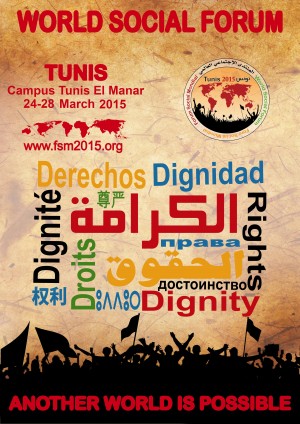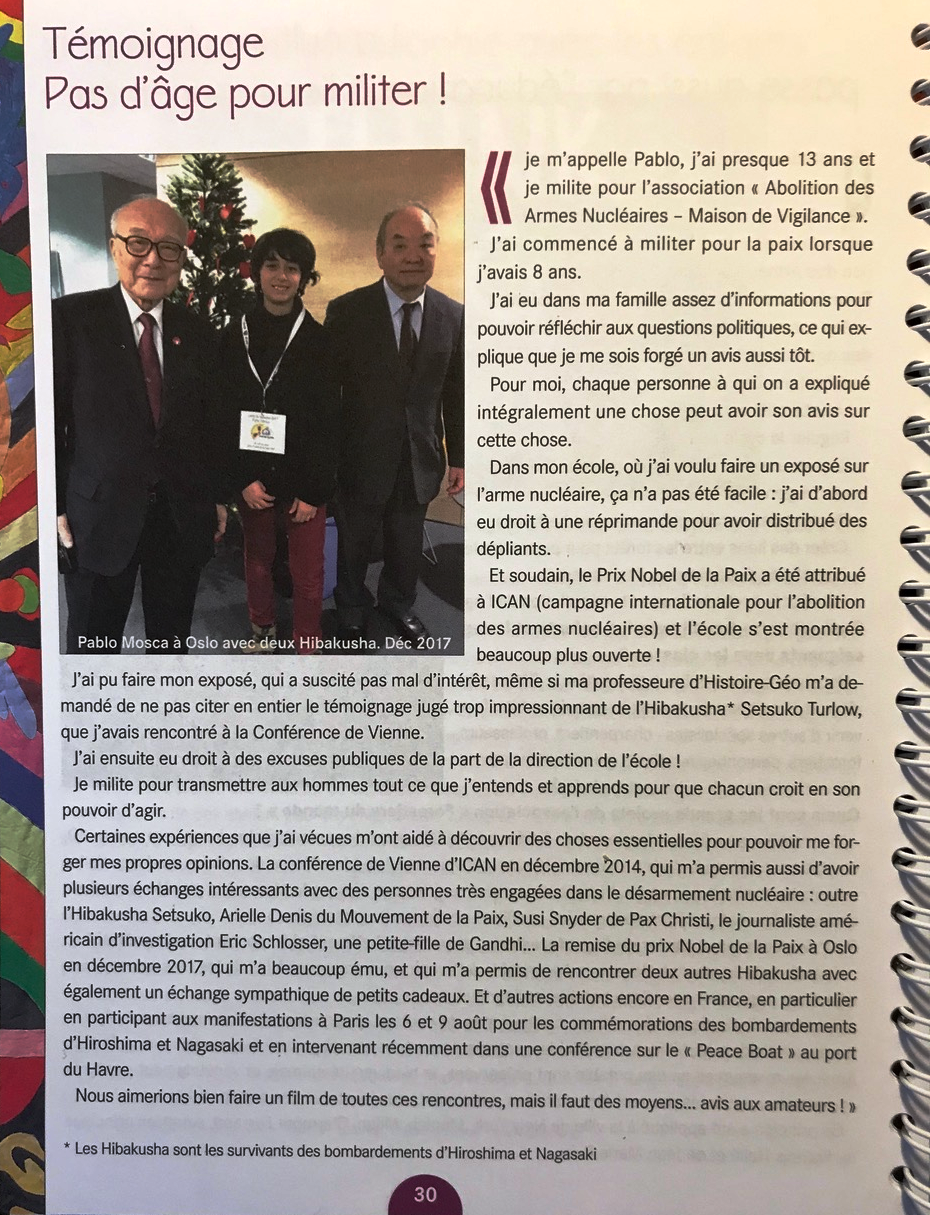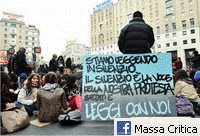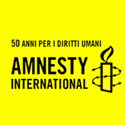Agenda 2019 del Mouvement de la Paix
“Le Mouvement de la Paix” is a French non-governmental organization founded in 1948 to oppose war and nuclear armaments, and to support international relations based on justice, democracy, and interpersonal cooperation. With offices around the country, the French Peace Movement promotes peaceful resolutions to violence through the alleyways of diplomacy and political negotiations. It supports those who work for peace in the hearts of conflicts, and the concept of worldwide peace through education and the creation of a culture of peace. The French Peace Movement is registered as a National Association of Youth and Popular Education.
Organization
In many cities across France, local branches of the French Peace Movement animate the debate and mobilize action around the construction of peace and the promotion of a culture of peace by partnering with other forces that work for a more just, secure, and peaceful world.
In addition to standard activism such as debates, petitions, art exhibitions, conferences, and protests, local branches of the Movement organize parties, concerts, parades, cruises, and international meetups.
The French Peace Movement brings together individuals with differing philosophical, religious, and political opinions, but who are all in agreement over the fact that the greatest threats to peace and security come from misery, poverty, unemployment, injustice, illiteracy, ignorance, and lack of democracy.
The Eight Points of the Decade
The French Peace Movement is proposing initiatives inspired by the Eight Central Points of the International Decade (United Nations/UNESCO) for the Promotion of a Culture of Peace and Nonviolence.
- The strengthening of a culture of peace through education
- The promotion of developing durable social and economic plans
- The promotion of respect for all human rights
- Taking measures to assure equality between men and women
- Taking measures to increase participation in democratic life
- Taking measures to develop understanding, tolerance, and solidarity
- Taking measures to support active communication, the free circulation of information, and the formation of relationships
- Taking measures to promote peace and international security
Youth Engagements
 In 2000, the Peace Movement came to the United Nations with 128 young people to deliver signatures collected in France during the Demonstration for a Culture of Peace and Nonviolence.
In 2000, the Peace Movement came to the United Nations with 128 young people to deliver signatures collected in France during the Demonstration for a Culture of Peace and Nonviolence.
Since then, we have created a youth network called “The Messengers of Peace” to facilitate national and international initiatives focused on young people.
With The Messengers of Peace we organized the International Gathering of European and Mediterranean Youths for a Culture of Peace in November 2002 in Marseilles with young adults from 15 different countries.
In August 2005, a delegation of 100 young people went to Hiroshima for the commemoration of the 60th anniversary of the bombing, and to participate in the Third International Meeting of Youths for a Culture of Peace and the Abolition of Nuclear Weapons accompanied by young Japanese, Europeans, Asians, and Americans. For more information visit (hyperlink).
In July 2011, a new International and European Meeting of Youths for a Culture of Peace gathered together nearly 200 young Europeans and others from all over the world in the Nièvre at Garchizy and Varennes-Vauzelles.
International Solidarity
The Peace Movement has been developing dynamic international solidarity by partnering with actors on the ground in the four corner of the world. The Movement is helping bring about the emergence of a new harmonious world by engaging as an actor in the global struggle to obtain the culture of peace promised by the United Nations. The Peace Movement participates in the renewal of pacifism by joining in the culture of peace, by opening up to all of society, and by welcoming in younger generations to succeed it. The Peace Movement works for conflict prevention by mobilizing against the causes of war.
History and Values
The origins of the Peace Movement are found in the creation of the “Combatants for Liberty” in the aftermath of the Second World War. It was the congressman (French equivalent) and resistance fighter Charles Tillon who, in 1947, took up the call to create an organization designed to “support the republican regime and prohibit the return of fascism and dictators.” Subsequently, on February 22, 1948, at l’Hôtel des Deux Mondes in Paris, about sixty members of the Resistance founded the “Combatants for Liberty” under the direction of Yves Farge, named the Prefect of the Rhône-Alpes Region by General de Gaulle. The positions of this youth movement whose goal is to preserve the united spirit of the Resistance were largely inspired by Raymond Aubrac.
After the 1948 Congress of People for Peace in Wroclaw, the global movement of peace fighters organized and created national committees. In France, the “Combatants for Liberty” became the “Combatants for Liberty and Peace.” Later, they became the “Combatants for Peace and Liberty.” Then in 1951 they became the “French National Council of the Peace Movement,” more commonly known as “The Peace Movement.”
- The promotion of a culture of peace through education
- The support of the Charter of the United Nations and the development of multilateral security organizations
- The end of wars and the peaceful settlement of conflict
- Nuclear disarmament and the elimination of nuclear weapons
- The shrinking of military budgets and the conversion of military industries
- The demilitarisation of international relations and the promotion of the security of all people
- The globalization of peace and the emergence of a new world
The Gallery of Art and Peace
A New Takeoff
A new takeo ff for art and peace!
ff for art and peace!
The Gallery of Art and Peace is now on the internet: www.artetpaix.net
Here you can choose gifts from a vast selection of artwork and reproductions of works by many contemporary artists since Picasso.
Our shop offers posters, reproductions, postcards, greeting cards, decorative plates, stamps, paintings, and more.
Some History
 In December 2004, the Gallery of Art and Peace inaugurated a new space for expositions and discussions. This inauguration gave an occasion to celebrate a rebirth and to pay homage to all the artists who had supported the work of the Peace Movement and the gallery. Created during the enormous pacifist momentum after the war by people like Frédérique Joliot-Curie, Pablo Picasso, and Eugénie Cotton, the Peace Movement immediately received the support of many artists, among the most influential at the time, who created stamps and posters to bring attention to the Movement’s work.
In December 2004, the Gallery of Art and Peace inaugurated a new space for expositions and discussions. This inauguration gave an occasion to celebrate a rebirth and to pay homage to all the artists who had supported the work of the Peace Movement and the gallery. Created during the enormous pacifist momentum after the war by people like Frédérique Joliot-Curie, Pablo Picasso, and Eugénie Cotton, the Peace Movement immediately received the support of many artists, among the most influential at the time, who created stamps and posters to bring attention to the Movement’s work.
Thus was born the image that would become the universal symbol for peace: Picasso’s Dove of Peace which he created as the emblem for the Peace Movement. The image was soon ubiquitous, notably because Picasso agreed to cede the rights of reproduction during his lifetime, as well as those of his original stamp designs. This necessitated the creation of a structure to manage the rights, and in 1950, the Gallery and Publisher of Art and Peace was founded.
The close and friendly relationships established early on with artists devoted to pacifist values continued and were strengthened over the years thanks to important artistic demonstrations for peace in the world. New generations of creators took over from their elders and diverse forms of support developed. This support includes collective exhibitions, stamp and poster publishing, donations of original works, and an exhibition/sale in 1996 bringing together 200 artists.
Recently, the Gallery of Art and Peace has had the pleasure and the honor to receive gifts from Ouanes Amor, Claude Bellegarde, Bertrand-Moulin, Nicole Bouret, Jean-Marc Brunet, John Christoforou, Monique Dollé-Lacour, Pierre Duclou, Albert Féraud, François Féret, Gérard Gosselin, Raymond Gosselin, François Hilsum, Luc Hoenraet, Jean-Pierre Jouffroy, Ladislas Kijno, André Le Glatin, Alain Le Yaouanc, Lybinka, Bata Mihaïlovitch, Jean Miotte, Henri Patez, Jean-Maurice Robert, Roger Somville, Yvon Taillandier, Claude Viseux, and others.
https://www.mvtpaix.org/wordpress/the-mouvement-de-la-paix-a-movement-of-peace/












